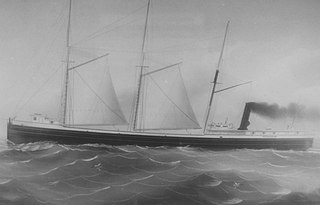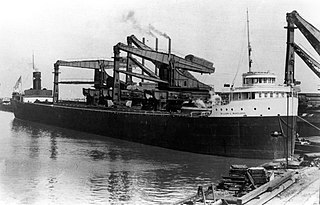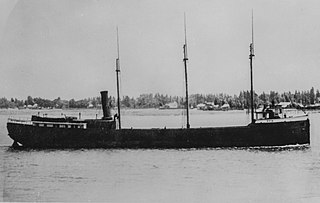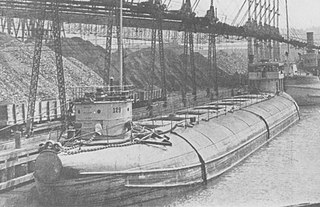
The SS Superior City was considered a pioneer vessel at her launching in 1898. She was the largest vessel ever built on freshwater at that time. She sailed the Great Lakes for twenty-two years until she sank after a collision in 1920 with the steamer Willis L. King in Whitefish Bay of Lake Superior that resulted in the loss of 29 lives. Controversy was immediate over the collision. It was subsequently ruled that the captains of both ships failed to follow the “rules-of-the-road”. Controversy started again in 1988 when the Great Lakes Shipwreck Historical Society produced a video called "Graveyard of the Great Lakes" that included extensive footage of the skeletons of the Superior City crew. The controversy continued as late as 1996 over artifacts removed from her wreck. She is now a protected shipwreck in the Whitefish Point Underwater Preserve.

SS Comet was a steamship that operated on the Great Lakes. Comet was built in 1857 as a wooden-hulled propeller-driven cargo vessel that was soon adapted to carry passengers. It suffered a series of maritime accidents prior to its final sinking in 1875 causing the loss of ten lives. It became known as the only treasure ship of Lake Superior because she carried 70 tons of Montana silver ore when it sank. The first attempts to salvage its cargo in 1876 and 1938 were unsuccessful. Comet was finally salvaged in the 1980s when the Great Lakes Shipwreck Historical Society illegally removed artifacts from the wreck. The artifacts are now the property of the State of Michigan and are on display as a loan to the Great Lakes Shipwreck Museum. The fate of her silver ore cargo is unknown. Comet's wreck is now protected by the Whitefish Point Underwater Preserve as part of an underwater museum.

The John M. Osborn was a wooden steam barge that sank in Lake Superior in 1884 with the loss of five lives. The Osborn was just 2 years old when the larger, steel-hulled Alberta, which was called a "steel monster" and "terror of the lakes", rammed her. The wreck of the Osborn was discovered 100 years after her sinking. The wreck was illegally salvaged in the 1980s. Many of Osborn's artifacts became the property of the State of Michigan after they were seized from Great Lakes Shipwreck Museum. The State allows the museum to display the artifacts as a loan. The wreck of the Osborn is now protected by the Whitefish Point Underwater Preserve as part of an underwater museum.

The SS Vienna was built in 1873 during the era when steamers were built with sail rigging. She had a 19 year career marked with maritime incidents including sinking when she was just three years old. She sank for her final time in fair weather in Whitefish Bay in Lake Superior after she received a mortal blow when she was inexplicably rammed by the steamer Nipigon. Although there were no deaths when the Vienna sank for the last time, more than 100 years later her wreck claimed the lives of 4 scuba divers, the most of all the wrecks in the Whitefish Point Underwater Preserve that now protects her as part of an underwater museum. Her wreck was stripped of artifacts that resulted in the Michigan Department of Natural Resources seizing her artifacts in a raid on the Great Lakes Shipwreck Museum in 1992. Her artifacts are now on display in this museum as loan from the State of Michigan.

The SS Samuel Mather was the first of seven U.S. merchant ships to bear that name. The wooden Mather sank in 1891 after she was rammed by the steel freighter Brazil in heavy fog in Whitefish Bay 8 miles (13 km) from Point Iroquois, ending the Mather's 4-year career. Her intact wreck is a rare of example of wooden freighters that plied the Great Lakes and she is a popular scuba diving site. Although there was no loss of life when the Mather sank, her wreck claimed the lives of three scuba divers more than 100 years after she sank. Artifacts from her wreck were illegally removed in the 1980s by the Great Lakes Shipwreck Historical Society. The artifacts are now the property of the State of Michigan and are on display as a loan to the Great Lakes Shipwreck Museum. The wreck of the Mather is protected as part of an underwater museum in the Whitefish Point Underwater Preserve.

SS John B. Cowle was one of the early Great Lakes bulk freighters known as "tin pans". She was the first of two ships named for prominent Cleveland, Ohio citizen and shipbuilder John Beswick Cowle. In 1909 on her maiden voyage SS Isaac M. Scott rammed John B. Cowle in heavy fog off Whitefish Point. John B. Cowle sank in three minutes, taking 14 of her 24-man crew with her. Artifacts from her wreck were illegally removed in the 1980s. Her artifacts are now the property of the State of Michigan and are on display as a loan to the Great Lakes Shipwreck Museum. The wreck of John B. Cowle is protected as part of an underwater museum in the Whitefish Point Underwater Preserve.

The Sagamore is reported to be the best example of a whaleback barge among Great Lakes shipwrecks. Only 44 whalebacks were ever built, and out of the 26 that sank, only 8 sank in the Great Lakes, most of them being blown up for blocking shipping channels. She sank in 1901 in the shipping lane near the Soo Locks when she was rammed by the steel steamer Northern Queen in one of Whitefish Bay's notorious fogs. Her captain and two crew members went down with her. Artifacts from her wreck were illegally removed in the 1980s. Her artifacts are now the property of the State of Michigan and are on display as a loan to the Great Lakes Shipwreck Museum. The wreck of the Sagamore is protected as part of an underwater museum in the Whitefish Point Underwater Preserve.

SS M.M. Drake was a wooden steam barge that towed consorts loaded with coal and iron ore on the Great Lakes. She came to the rescue of the crews of at least four foundering vessels in her 19-year career only to meet the same fate in her final rescue attempt. Drake sank in 1901 off Vermilion Point after a rescue attempt of her consort Michigan. Her rudder, anchor, and windlass were illegally removed from her wreck site in the 1980s. They are now the property of the State of Michigan. The rudder is on display as a loan to the Great Lakes Shipwreck Museum and the anchor and windlass are on loan for display to Whitefish Township Community Center. The wreck of Drake is protected as part of an underwater museum in the Whitefish Point Underwater Preserve.

The lake freighter SS Henry Steinbrenner was a 427-foot (130 m) long, 50-foot (15 m) wide, and 28-foot (8.5 m) deep, dry bulk freighter of typical construction style for the early 1900s, primarily designed for the iron ore, coal, and grain trades on the Great Lakes. Commissioned by the Kinsman Transit Co. of Cleveland, Ohio she was launched as hull number 14 by Jenks Ship Building Co. of Port Huron, Michigan. Her design featured a forward forecastle containing crew cabins topped with an additional cabin and pilot house. The mid section was a long nearly flat deck over the cargo holds only interrupted by 12 hatches fitted with telescoping type hatch covers. The aft end featured a large cabin situated over the engine room containing the galley, mess rooms, and crew quarters and was topped with a smoke stack and air vents. The Steinbrenner later featured a "doghouse" cabin aft of her smoke stack to house added crew from a change in the crew watch system on the Great Lakes.

SS Myron was a wooden steamship built in 1888. She spent her 31-year career as lumber hooker, towing schooner barges on the Great Lakes. She sank in 1919, in a Lake Superior November gale. All of her 17 crew members were killed but her captain survived. He was found drifting on wreckage near Ile Parisienne. Her tow, the Miztec, survived. Myron defied the adage that Lake Superior "seldom gives up her dead" when all 17 crewmembers were found frozen to death wearing their life jackets. Local residents chopped eight of Myron's sailors from the ice on the shore of Whitefish Bay and buried them at the Mission Hill Cemetery in Bay Mills Township, Michigan.

Miztec was built as a three-masted schooner in 1890. She was later converted to a schooner barge and served as a consort for lumber hookers on the Great Lakes. She escaped destruction in a severe 1919 storm that sank her longtime companion, the SS Myron, only to sink on the traditional day of bad luck, Friday the 13th in May 1921, with the loss of all hands. She came to rest on Lake Superior's bottom off Whitefish Point near the Myron.

The SS Charles S. Price was a steel-hulled ship lost on Lake Huron on November 9, 1913 during the Great Lakes storm of 1913. Twenty eight people died.

SS William C. Moreland was a 600-foot (180 m) long Great Lakes freighter that ran aground on Sawtooth Reef, Lake Superior on 18 October 1910, only a month after entering service. Visibility was poor due to the smoke from several forest fires, causing the William C. Moreland to ran full steam onto a reef. There were many attempts to salvage the ship, but eventually only the 278-foot (85 m) long stern was salvaged and was used to build the 580-foot (180 m) long Sir Trevor Dawson.

Antelope was a Great Lakes steamship that later was converted into a schooner barge) and sank in Lake Superior near the Apostle Islands in 1897.

SS Ohio was a wooden hulled Great Lakes freighter that served on the Great Lakes of North America from her construction in 1875, to her sinking in September 1894 when she collided with the schooner barge Ironton which also sank in the collision. Ironton was being towed by the steamer Charles J. Kershaw, which was also towing the schooner Moonlight. Ohio was found upright in 2017, over 122 years after her sinking in over 200 feet of water off Presque Isle, Michigan. In March, 2023, it was announced that Ironton had been located in 2019. The researchers who discovered Ohio plan to nominate her for a listing in the National Register of Historic Places.

SS Hudson was a steel-hulled package freighter that served on the Great Lakes from her construction in 1887 to her sinking in 1901. On September 16, 1901, while heading across Lake Superior with a cargo of wheat and flax, she ran into a storm and sank with the loss of all 25 crew off Eagle Harbor, Michigan. For nearly 118 years the location of Hudson's wreck remained unknown, until in July 2019 her wreck was found in 825 feet (251 m) of water, completely intact.

SS S.R. Kirby was a composite-hulled bulk carrier that served on the Great Lakes of North America from her construction in 1890 to her sinking in 1916. On May 8, 1916, while heading across Lake Superior with a cargo of iron ore and the steel barge George E. Hartnell in tow, she ran into a storm and sank with the loss of all but two of her 22-man crew off Eagle Harbor, Michigan. For over 102 years the location of S.R. Kirby's wreck remained unknown, until June 2018, when her wreck was discovered by the Great Lakes Shipwreck Historical Society (GLSHS) in 825 feet (251 m) of water, completely broken up.

Gunilda was a steel-hulled Scottish-built steam yacht in service between her construction in 1897 and her sinking in Lake Superior in 1911. Built in 1897 in Leith, Scotland by Ramage & Ferguson for J. M. or A. R. & J. M. Sladen, and became owned by F. W. Sykes in 1898; her first and second owners were all from England. In 1901, Gunilda was chartered by a member of the New York Yacht Club, sailing across the Atlantic Ocean with a complement of 25 crewmen. In 1903, she was purchased by oil baron William L. Harkness of Cleveland, Ohio, a member of the New York Yacht Club; she ended up becoming the club's flagship. Under Harkness' ownership, Gunilda visited many parts of the world, including the Caribbean, and beginning in 1910, the Great Lakes.

129 was an American whaleback barge in service between 1893 and 1902. She was built between December 1892 and May 1893, in Superior, Wisconsin,, by Alexander McDougall's American Steel Barge Company, for McDougall's fleet of the same name, based in Buffalo, New York. She was one of a class of distinctive and experimental ships designed and built by McDougall. The whalebacks were designed to be more stable in high seas. They had rounded decks, and lacked the normal straight sides seen on traditional lake freighters. 129 entered service on May 22, hauling wheat from Superior. She was sold to the Bessemer Steamship Company of Cleveland, Ohio, in 1900. In 1901, she became owned by the Pittsburgh Steamship Company of Duluth, Minnesota, when the Bessemer fleet merged into it.



















